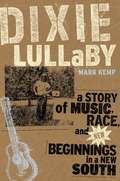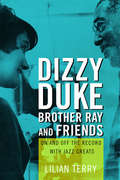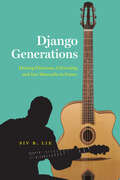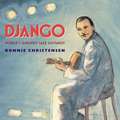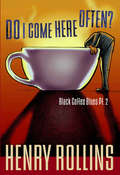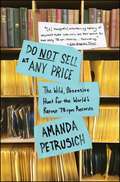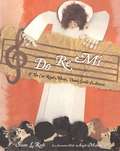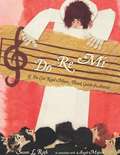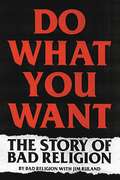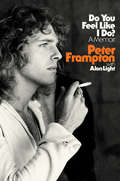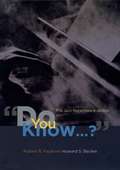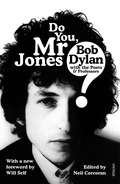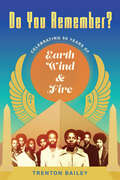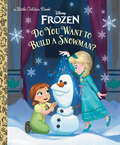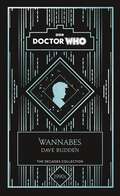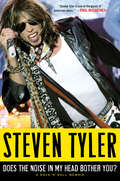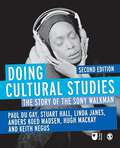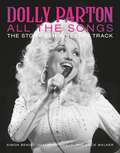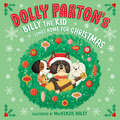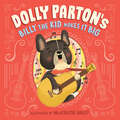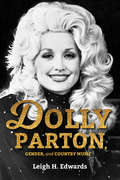- Table View
- List View
Dixie Lullaby
by Mark KempRock & roll has transformed American culture more profoundly than any other art form. During the 1960s, it defined a generation of young people as political and social idealists, helped end the Vietnam War, and ushered in the sexual revolution. In Dixie Lullaby, veteran music journalist Mark Kemp shows that rock also renewed the identity of a generation of white southerners who came of age in the decade after segregation -- the heyday of disco, Jimmy Carter, and Saturday Night Live. Growing up in North Carolina in the 1970s, Kemp experienced pain, confusion, and shame as a result of the South's residual civil rights battles. His elementary school was integrated in 1968, the year Kemp reached third grade; his aunts, uncles, and grandparents held outdated racist views that were typical of the time; his parents, however, believed blacks should be extended the same treatment as whites, but also counseled their children to respect their elder relatives. "I loved the land that surrounded me but hated the history that haunted that land," Kemp writes. When rock music, specifically southern rock, entered his life, he began to see a new way to identify himself, beyond the legacy of racism and stereotypes of southern small-mindedness that had marked his early childhood. Well into adulthood Kemp struggled with the self-loathing familiar to many white southerners. But the seeds of forgiveness were planted in adolescence when he first heard Duane Allman and Ronnie Van Zant pour their feelings into their songs. In the tradition of music historians such as Nick Tosches and Peter Guralnick, Kemp masterfully blends into his narrative the stories of southern rock bands --from heavy hitters such as the Allman Brothers Band, Lynyrd Skynyrd, and R.E.M. to influential but less-known groups such as Drive-By Truckers -- as well as the personal experiences of their fans. In dozens of interviews, he charts the course of southern rock & roll. Before civil rights, the popular music of the South was a small, often racially integrated world, but after Martin Luther King Jr.'s assassination, black musicians struck out on their own. Their white counterparts were left to their own devices, and thus southern rock was born: a mix of popular southern styles that arose when predominantly white rockers combined rural folk, country, and rockabilly with the blues and jazz of African-American culture. This down-home, flannel-wearing, ass-kicking brand of rock took the nation by storm in the 1970s. The music gave southern kids who emulated these musicians a newfound voice. Kemp and his peers now had something they could be proud of: southern rock united them and gave them a new identity that went beyond outside perceptions of the South as one big racist backwater. Kemp offers a lyrical, thought-provoking, searingly intimate, and utterly original journey through the South of the 1960s, '70s, '80s, and '90s, viewed through the prism of rock & roll. With brilliant insight, he reveals the curative and unifying impact of rock on southerners who came of age under its influence in the chaotic years following desegregation. Dixie Lullaby fairly resonates with redemption.
Dixie Lullaby: A Story of Music, Race, and New Beginnings in a New South
by Mark KempRock & roll has transformed American culture more profoundly than any other art form. During the 1960s, it defined a generation of young people as political and social idealists, helped end the Vietnam War, and ushered in the sexual revolution. In Dixie Lullaby,veteran music journalist Mark Kemp shows that rock also renewed the identity of a generation of white southerners who came of age in the decade after segregation- the heyday of disco, Jimmy Carter, and Saturday Night Live. Growing up in North Carolina in the 1970s, Kemp experienced pain, confusion, and shame as a result of the South's residual civil rights battles. His elementary school was integrated in 1968, the year Kemp reached third grade; his aunts, uncles, and grandparents held outdated racist views that were typical of the time; his parents, however, believed blacks should be extended the same treatment as whites, but also counseled their children to respect their elder relatives. "I loved the land that surrounded me but hated the history that haunted that land," Kemp writes. When rock music, specifically southern rock, entered his life, he began to see a new way to identify himself, beyond the legacy of racism and stereotypes of southern small-mindedness that had marked his early childhood. Well into adulthood Kemp struggled with the self-loathing familiar to many white southerners. But the seeds of forgiveness were planted in adolescence when he first heard Duane Allman and Ronnie Van Zant pour their feelings into their songs. In the tradition of music historians such as Nick Tosches and Peter Guralnick, Kemp masterfully blends into his narrative the stories of southern rock bands- from heavy hitters such as the Allman Brothers Band, Lynyrd Skynyrd, and R.E.M. to influential but less-known groups such as Drive-By Truckers- as well as the personal experiences of their fans. In dozens of interviews, he charts the course of southern rock & roll. Before civil rights, the popular music of the South was a small, often racially integrated world, but after Martin Luther King Jr. 's assassination, black musicians struck out on their own. Their white counterparts were left to their own devices, and thus southern rock was born: a mix of popular southern styles that arose when predominantly white rockers combined rural folk, country, and rockabilly with the blues and jazz of African-American culture. This down-home, flannel-wearing, ass-kicking brand of rock took the nation by storm in the 1970s. The music gave southern kids who emulated these musicians a newfound voice. Kemp and his peers now had something they could be proud of: southern rock united them and gave them a new identity that went beyond outside perceptions of the South as one big racist backwater. Kemp offers a lyrical, thought-provoking, searingly intimate, and utterly original journey through the South of the 1960s, '70s, '80s, and '90s, viewed through the prism of rock & roll. With brilliant insight, he reveals the curative and unifying impact of rock on southerners who came of age under its influence in the chaotic years following desegregation. Dixie Lullaby fairly resonates with redemption.
Dizzy, Duke, Brother Ray, and Friends: On and Off the Record with Jazz Greats
by Lillian TerryLilian Terry has lived music. As a performer, she has shared the stage with Ella Fitzgerald and Nina Simone. She cofounded the European Jazz Federation and pioneered jazz education in Italy. Her work as a director-producer of radio and television programs have spread the music by introducing countless people to its legendary performers. Drawing on Terry's long friendships and professional associations, Dizzy, Duke, Brother Ray, and Friends offers readers a rare opportunity to hear intimate conversations with some of the world's greatest musical figures. Dizzy Gillespie offers his thoughts on playing with œsanctified rhythm and the all-important personal touch in performance. Duke Ellington discourses on jazz history and concludes an interview to sing a self-written ditty in Italian. Ray Charles gives candid thoughts on race and politics while taking charge of Terry's tape recorder. Abbey Lincoln, Max Roach, Horace Silver, Bill Evans ”all provide Terry and her readers with unforgettable encounters. The result is a collection of profiles, some stretching over a decade or more, that reveal these performers in ways that illuminates their humanity and expands our appreciation of their art.
Django Generations: Hearing Ethnorace, Citizenship, and Jazz Manouche in France (Chicago Studies in Ethnomusicology)
by Siv B. LieDjango Generations shows how relationships between racial identities, jazz, and national belonging become entangled in France. Jazz manouche—a genre known best for its energetic, guitar-centric swing tunes—is among France’s most celebrated musical practices of the twentieth and twenty-first centuries. It centers on the recorded work of famed guitarist Django Reinhardt and is named for the ethnoracial subgroup of Romanies (also known, often pejoratively, as “Gypsies”) to which Reinhardt belonged. French Manouches are publicly lauded as bearers of this jazz tradition, and many take pleasure and pride in the practice while at the same time facing pervasive discrimination. Jazz manouche uncovers a contradiction at the heart of France’s assimilationist republican ideals: the music is portrayed as quintessentially French even as Manouches themselves endure treatment as racial others. In this book, Siv B. Lie explores how this music is used to construct divergent ethnoracial and national identities in a context where discussions of race are otherwise censured. Weaving together ethnographic and historical analysis, Lie shows that jazz manouche becomes a source of profound ambivalence as it generates ethnoracial difference and socioeconomic exclusion. As the first full-length ethnographic study of French jazz to be published in English, this book enriches anthropological, ethnomusicological, and historical scholarship on global jazz, race and ethnicity, and citizenship while showing how music can be an important but insufficient tool in struggles for racial and economic justice.
Django: World's Greatest Jazz Guitarist
by Bonnie Christensen"When I think about the best guitar players ever, the first name that comes to mind is Django Reinhardt. No one has ever equaled his sound or techniques." - Willie Nelson<P><P> Born into extreme poverty in a gypsy encampment, Django Reinhardt (1910-1953) overcame tremendous obstacles, including a debilitating injury, to become the world's most acclaimed jazz guitarist.<P> Here, Bonnie Christensen tells his story with a haunting, rhythmic, jazz-inflected text and lush oil paintings that capture the spirit of both the man and his music.<P> Jazz Americain, [scanner's note this is cain not just can] jazz like Django--moving bending changing blending<P> Try that rhythm, stretch that measure, syncopation.<P> Twist that line.<P> Winner of the Schneider Family Book Award
Do I Come Here Often?
by Henry RollinsDo I Come Here Often? includes interviews with Jerry Lee Lewis and Isaac Hayes, articles on Roky Erickson and David Lee Roth and Rollins' 1991 Lollapalooza tour journals and features illustrations by Shannon Wheeler ("Too Much Coffee Man").
Do Not Sell At Any Price
by Amanda PetrusichThe untold story of a quirky and important subculture: The world of 78rpm records and the insular community that celebrates them--by acclaimed music critic and author Amanda Petrusich, who contributes regularly to Pitchfork, The Oxford American, and The New York Times.Before MP3s, CDs, and cassette tapes, even before LPs or 45s, the world listened to music on 78rpm records--those fragile, 10-inch shellac discs. While vinyl records have enjoyed a renaissance in recent years, good 78s are exponentially harder to come by and play. A recent eBay auction for the only known copy of a particular record topped out at $37,100. Do Not Sell at Any Price explores the rarified world of the 78rpm record--from the format's heyday to its near extinction--and how collectors and archivists are working frantically to preserve the music before it's lost forever. Through fascinating historical research and beguiling visits with the most prominent 78 preservers, Amanda Petrusich offers both a singular glimpse of the world of 78 collecting and the lost backwoods blues artists whose 78s from the 1920s and 1930s have yet to be found or heard by modern ears. We follow the author's descent into the oddball fraternity of collectors--including adventures with Joe Bussard, Chris King, John Tefteller, Pete Whelan, and more--who create and follow their own rules, vocabulary, and economics and explore the elemental genres of blues, folk, jazz, and gospel that gave seed to the rock, pop, country, and hip-hop we hear today. From Thomas Edison to Jack White, Do Not Sell at Any Price is an untold, intriguing story of preservation, loss, obsession, art, and the evolution of the recording formats that have changed the ways we listen to (and create) music.
Do Re Mi
by Susan L. Roth Angelo MafucciIf you can read musical notes, you can sing any song or play any piece. But musical notes have not always been here. Long ago, songs were memorized. If songs were forgotten, they were lost forever. Thanks to one man, Guido d’Arezzo, music now can last forever.
Do Re Mi: If You Can Read Music, Thank Guido d'Arezzo
by Susan L. RothIf you can read musical notes, you can sing any song or play any piece. But musical notes have not always been here. Long ago, songs were memorized. If songs were forgotten, they were lost forever. Thanks to one man, Guido d’Arezzo, music now can last forever.
Do What You Want: The Story of Bad Religion
by Bad ReligionFrom their beginnings as teenagers experimenting in a San Fernando Valley garage dubbed "The Hell Hole" to headlining major music festivals around the world, Do What You Wanttells the whole story of Bad Religion's 40-year career in irreverent style. Do What You Want: The Bad Religion Story reveals the ups and downs of the band's forty-year career. From their beginnings as teenagers jamming in a San Fernando Valley garage dubbed "The Hell Hole" to headlining major music festivals around the world, Do What You Want tells the whole story in irreverent style.While Do What You Want tracks down nearly all of Bad Religion's members past and present, the chief storytellers are the four voices that define Bad Religion: Greg Graffin, a Wisconsin kid who sang in the choir and became an L.A. punk rock icon while he was still a teenager; Brett Gurewitz, a high school dropout who founded the independent punk label Epitaph Records and went on to become a record mogul; Jay Bentley, a surfer and skater who gained recognition as much for his bass skills as for his onstage antics; and Brian Baker, a founding member of Minor Threat who joined the band in 1994 and brings a fresh perspective as an intimate outsider. With a unique blend of melodic hardcore and thought-provoking lyrics, Bad Religion paved the way for the punk rock explosion of the 1990s, opening the door for bands like NOFX, The Offspring, Rancid, Green Day, and Blink-182 to reach wider audiences. They showed the world what punk could be, and they continue to spread their message one song, one show, one tour at a time -- with no signs of stopping.
Do You Feel Like I Do?: A Memoir
by Peter FramptonA revelatory memoir by rock icon and legendary guitarist Peter Frampton.Do You Feel Like I Do? is the incredible story of Peter Frampton's positively resilient life and career told in his own words for the first time. His monu-mental album Frampton Comes Alive! spawned three top-twenty singles and sold eight million copies the year it was released (more than seventeen million to date), and it was inducted into the Grammy Hall of Fame in January 2020. <P><P>Frampton was on a path to stardom from an early age, first as the lead singer and guitarist of the Herd and then as cofounder -- along with Steve Marriott -- of one of the first supergroups, Humble Pie. Frampton was part of a tight-knit collective of British '60s musicians with close ties to the Rolling Stones, the Beatles, and the Who. This led to Frampton playing on George Harrison's solo debut, All Things Must Pass, as well as to Ringo Starr and Billy Preston appearing on Frampton's own solo debut. By age twenty-two, Frampton was touring incessantly and finding new sounds with the talk box, which would become his signature guitar effect. <P><P>Frampton remembers his enduring friendship with David Bowie. Growing up as schoolmates, crossing paths throughout their careers, and playing together on the Glass Spider Tour, the two developed an unshakable bond. Frampton also shares fascinating stories of his collaborative work with Harry Nilsson, Stevie Wonder, B. B. King, and members of Pearl Jam. He reveals both the blessing and curse of Frampton Comes Alive!, opening up about becoming the cover boy he never wanted to be, his overcoming sub-stance abuse, and how he has continued to play and pour his heart into his music despite an inflammatory muscle disease and his retirement from the road. <P><P>Peppered throughout his narrative is the story of his favorite guitar, the Phenix, which he thought he'd lost in a fiery plane crash in 1980. But in 2011, it mysteriously showed up again -- saved from the wreckage. Frampton tells of that unlikely reunion here in full for the first time, and why the miraculous reappearance is emblematic of his life and career as a quintessential artist. <P><P><b>A New York Times Bestseller</b>
Do You Know...?: The Jazz Repertoire in Action
by Howard S. Becker Robert R. FaulknerEvery night, somewhere in the world, three or four musicians will climb on stage together. Whether the gig is at a jazz club, a bar, or a bar mitzvah, the performance never begins with a note, but with a question. The trumpet player might turn to the bassist and ask, “Do you know ‘Body and Soul’?”—and from there the subtle craft of playing the jazz repertoire is tested in front of a live audience. These ordinary musicians may never have played together—they may never have met—so how do they smoothly put on a show without getting booed offstage. In “Do You Know . . . ?” Robert R. Faulkner and Howard S. Becker—both jazz musicians with decades of experience performing—present the view from the bandstand, revealing the array of skills necessary for working musicians to do their jobs. While learning songs from sheet music or by ear helps, the jobbing musician’s lexicon is dauntingly massive: hundreds of thousands of tunes from jazz classics and pop standards to more exotic fare. Since it is impossible for anyone to memorize all of these songs, Faulkner and Becker show that musicians collectively negotiate and improvise their way to a successful performance. Players must explore each others’ areas of expertise, develop an ability to fake their way through unfamiliar territory, and respond to the unpredictable demands of their audience—whether an unexpected gang of polka fanatics or a tipsy father of the bride with an obscure favorite song.“Do You Know . . . ?” dishes out entertaining stories and sharp insights drawn from the authors’ own experiences and observations as well as interviews with a range of musicians. Faulkner and Becker’s vivid, detailed portrait of the musician at work holds valuable lessons for anyone who has to think on the spot or under a spotlight.
Do You Mr Jones?: Bob Dylan with the Poets and Professors
by Neil CorcoranIn 2016, Bob Dylan received the Nobel Prize in Literature ‘for having created new poetic expressions within the great American song tradition’. This collection of essays by leading poets and critics – with a new foreword by Will Self – examines Dylan’s poetic genius, as well as his astounding cultural influence over the decades.‘From Orpheus to Faiz, song and poetry have been closely linked. Dylan is the brilliant inheritor of the bardic tradition’ Salman Rushdie‘The most significant Western popular artist in any form or medium of the past sixty years’ Will Self‘For fifty and some years he has bent, coaxed, teased and persuaded words into lyric and narrative shapes that are at once extraordinary and inevitable’ Andrew Motion‘His haunting music and lyrics have always seemed, in the deepest sense, literary’ Joyce Carol Oates‘There is something inevitable about Bob Dylan… A storyteller pulling out all the stops – metaphor, allegory, repetition, precise detail… His virtue is in his style, his attitude, his disposition to the world’ Simon Armitage
Do You Remember House?: Chicago's Queer of Color Undergrounds
by Micah E. SalkindToday, no matter where you are in the world, you can turn on a radio and hear the echoes and influences of Chicago house music. <p><p>Do You Remember House? tells a comprehensive story of the emergence, and contemporary memorialization of house in Chicago, tracing the development of Chicago house music culture from its beginnings in the late '70s to the present. Based on expansive research in archives and his extensive conversations with the makers of house in Chicago's parks, clubs, museums, and dance studios, author Micah Salkind argues that the remediation and adaptation of house music by crossover communities in its first decade shaped the ways that Chicago producers, DJs, dancers, and promoters today re-remember and mobilize the genre as an archive of collectivity and congregation. The book's engagement with musical, kinesthetic, and visual aspects of house music culture builds from a tradition of queer of color critique. As such, Do You Remember House? considers house music's liberatory potential in terms of its genre-defiant repertoire in motion. <p><p>Ultimately, the book argues that even as house music culture has been appropriated and exploited, the music's porosity and flexibility have allowed it to remain what pioneering Chicago DJ Craig Cannon calls a "musical Stonewall" for queers and people of color in the Windy City and around the world.
Do You Remember?: Celebrating Fifty Years of Earth, Wind & Fire (American Made Music Series)
by Trenton BaileyIn Do You Remember? Celebrating Fifty Years of Earth, Wind & Fire, Trenton Bailey traces the humble beginning of Maurice White, his development as a musician, and his formation of Earth, Wind & Fire, a band that became a global phenomenon during the 1970s. By the early 1980s, the music industry was changing, and White had grown weary after working constantly for more than a decade. He decided to put the band on hiatus for more than three years. The band made a comeback in 1987, but White’s health crisis soon forced them to tour without him. During the twenty-first century, the band has received numerous accolades and lifetime achievement and hall of fame awards. The band remains relevant today, collaborating with younger artists and maintaining their classic sound. Earth, Wind & Fire stood apart from other soul bands with their philosophical lyrics and extravagant visual art, much of which is studied in the book, including album covers, concerts, and music videos. The lyrics of hit songs are examined alongside an analysis of the band’s chart success. Earth, Wind & Fire has produced twenty-one studio albums and several compilation albums. Each album is analyzed for content and quality. Earth, Wind & Fire is also known for using ancient Egyptian symbols, and Bailey thoroughly details those symbols and Maurice White’s fascination with Egyptology. After enduring many personnel changes, Earth, Wind & Fire continues to perform around the world and captivate diverse audiences.
Do You Want to Build a Snowman? (Little Golden Book)
by Golden BooksSing along to the beloved Disney Frozen song &“Do You Want to Build a Snowman?&” with this beautifully illustrated Little Golden Book starring Elsa and Anna!Join Princess Anna as she rides her bike around the castle, talks to paintings on the wall, and asks her sister again and again, &“Do you want to build a snowman?&”. This adorable Little Golden Book features the lyrics of the super catchy Disney Frozen song &“Do You Want to Build a Snowman?&” as well as beautiful images showing the sisters&’ journey throughout the film. It is sure to be a must-have for fans ages 2 to 5 and Little Golden Book collectors of all ages!
Doctor Who: a 1990s story
by Dave Rudden Doctor Who*Part of the six books for six decades collection*It's Dublin in 1994, and the Doctor and Donna have arrived at the tiny nightclub known as Tripod.Tripod is famous for precisely one thing - the night where four young women came together to make the biggest girl band of the 90s: the Blood Honeys.Donna has convinced the Doctor to visit their first ever concert - and he has begrudgingly agreed.Naturally the band is kidnapped by a deadly pack of siren-like creatures who feed off human adulation, with an eye on taking over the world.With Dublin and the world to save, Donna may get her chance to perform on the world's biggest stage . . .
Does the Noise in My Head Bother You?: A Rock 'n' Roll Memoir
by Steven Tyler"I've been mythicized, Mick-icized, eulogized and fooligized, I've been Cole-Portered and farmer's-daughtered, I've been Led Zepped and 12-stepped. I'm a rhyming fool and so cool that me, Fritz the Cat, and Mohair Sam are the baddest cats that am. I have so many outrageous stories, too many, and I'm gonna tell 'em all. All the unexpurgated, brain-jangling tales of debauchery, sex & drugs, transcendence & chemical dependence you will ever want to hear." The son of a classical pianist straight out of the Bronx of old Archie comics, Steven Tyler was born to be a rock star. Weaned on Cole Porter, Nat King Cole, Mick-and his beloved Janis Joplin-Tyler began tearing up the streets and the stage as a teenager before finally meeting his "mutant twin" and legendary partner Joe Perry. In this addictively readable memoir, told in the playful, poetic voice that is uniquely his own, Tyler unabashedly recounts the meteoric rise, fall, and rise of Aerosmith over the last three decades and riffs on the music that gives it all meaning. Tyler tells what it's like to be a living legend and the frontman of one of the world's most revered and infamous bands-the debauchery, the money, the notoriety, the fights, the motels and hotels, the elevators, limos, buses and jets, the rehab. He reveals the spiritual side that "gets lost behind the stereotype of the Sex Guy, the Drug Guy, the Demon of Screamin', the Terror of the Tropicana." And he talks about his epic romantic life and his relationship with his four children. As dazzling, bold, and out-on-the-edge as the man himself, Does the Noise in My Head Bother You? is an all-access backstage pass into this extraordinary showman's life.
Doing Cultural Studies: The Story of the Sony Walkman (Culture, Media and Identities)
by Paul Du Gay Stuart Hall Linda Janes Hugh Mackay Keith Negus Anders Koed MadsenWhy think about the Walkman in the 21st century? Can the Walkman help us understand today’s media and cultural practices? Through the notion of the ′circuit of culture′, this book teaches students to critically examine what culture means, and how and why it is enmeshed with the media texts and objects in their lives.
Doing Our Own Thing: The Degradation of Language and Music and Why We Should, Like, Care
by John McWhorterEncourages readers to establish a boundary between an acceptable evolution of language and outright language misuse, predicting the consequences of the overuse of street English in today's writing, music, and society. By the author of The Power of Babel. 50,000 first printing.
Doktor Faustus (ver-)stimmen: Kompositionen zu Thomas Manns Roman
by Anna Maria OlivariIn diesem Open-Access-Buch widmet sich Anna Maria Olivari der Forschungslücke der Vertonung von Thomas Manns Doktor Faustus. Sie untersucht ein Korpus von 13 unterschiedlichen Kompositionen aus dem Bereich der Neuen Musik (Opern, Monodramen, instrumentale Werke), die zwischen 1952 und 2011 entstanden sind und bisher wenig bis gar nicht rezipiert wurden. Thomas Manns Doktor Faustus ist in vielerlei Hinsicht ein breit erforschtes Werk, jedoch nicht in Bezug auf seine Vertonungen. Der Vergleich zwischen Roman und Komposition ist im Forschungsparadigma der Intermedialität angesiedelt und ermöglicht die Rekonstruktion der kompositorischen Rezeptionsgeschichte von Doktor Faustus. Die Rückkopplungseffekte zwischen Text und Musik lassen Thomas Manns Roman neu lesen.
Dolly Parton All the Songs: The Story Behind Every Track (All the Songs)
by Lalie Walker Simon Benoît Damien SomvilleTake a deep dive into Dolly Parton&’s almost 60 year career with this complete guide featuring more than 400 photographs, little-known stories behind each album, and behind-the-scenes details about the recording of each track, the musicians involved, and the songwriting process. Organized chronologically, and covering every album and every song that Dolly has ever released, Dolly Parton All the Songs is the result of years of research by three Dolly megafans and longtime music journalists. Beginning with a childhood famously spent making music with her family in Tennessee's Great Smoky Mountains, Dolly Parton All the Songs follows along as the country music superstar conquers Nashville, Hollywood, and then the world with her captivating music, unforgettable style, and unmatched humor and kindness. At 608 pages, Dolly Parton All the Songs is filled with amazing photographs of Dolly in all her glory, and it features tons of fascinating details about Dolly's recording process, including which musicians appeared on each track, and little-known details about her working relationship with Porter Wagoner (she wrote the classic track "I Will Always Love You" about him), as well as looking at her forays into film stardom with appearances in classic movies like 9 to 5, Steel Magnolias, and the recent Netflix series, Heartstrings. This is a must-have book for any fan of Dolly Parton and country music.
Dolly Parton's Billy the Kid Comes Home for Christmas
by Erica S. Perl Dolly PartonIn this standalone sequel to instant New York Times Bestseller Dolly Parton's Billy the Kid Makes it Big, Dolly's favorite god-dog is back with a tale about the true meaning of Christmas.French bulldog Billy the Kid is one lucky pup. He has everything he could ever want: a place in Nashville, a great band, and even a cross-country tour. It's all totally tail-riffic...but he can't help but feel that something's missing. When Billy's band is scheduled to perform at Barkafeller Center on Christmas Day, he'll have to decide what matters most to him: fame or family?Written by Dolly Parton with Erica S. Perl and illustrated by MacKenzie Haley, this is a hilarious yet heartwarming picture book about the importance of family, friendship, and of course, paw-some music.
Dolly Parton's Billy the Kid Makes It Big
by Erica S. Perl Dolly PartonFrom the legendary Dolly Parton comes a story about her god-dog and Instagram personality, Billy the Kid, who is hoping to make it big as a country music star in Nashville, Tennessee. <p><p>French bulldog Billy the Kid was born with an ear for music. And not just any music. He loves barking to the beat of country music! So Billy sets out to Nashville to sing his heart out.But when he meets some big bullies at the Battle of the Bow-wows, Billy worries he's barking up the wrong tree. He'll need his favorite songs ("Jowlene" and "I Will Pawlways Love You," of course), a group of scrappy new friends, and his favorite country music star to regain self-confidence and be the star he always knew he could be. <p><p>Written by Dolly Parton with Erica S. Perl and illustrated by MacKenzie Haley, this is a delightful picture book about standing up to people (and dogs) who put you down and finding the drive to achieve your dreams.
Dolly Parton, Gender, and Country Music
by Leigh H. EdwardsDolly Parton is instantly recognizable for her iconic style and persona, but how did she create her enduring image? Dolly crafted her exaggerated appearance and stage personality by combining two opposing stereotypes—the innocent mountain girl and the voluptuous sex symbol. Emerging through her lyrics, personal stories, stage presence, and visual imagery, these wildly different gender tropes form a central part of Dolly’s media image and portrayal of herself as a star and celebrity. By developing a multilayered image and persona, Dolly both critiques representations of femininity in country music and attracts a diverse fan base ranging from country and pop music fans to feminists and gay rights advocates. In Dolly Parton, Gender, and Country Music, Leigh H. Edwards explores Dolly’s roles as musician, actor, author, philanthropist, and entrepreneur to show how Dolly’s gender subversion highlights the challenges that can be found even in the most seemingly traditional form of American popular music. As Dolly depicts herself as simultaneously "real" and "fake," she offers new perspectives on country music’s claims of authenticity.
